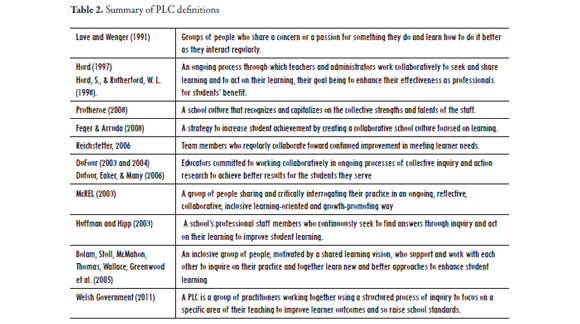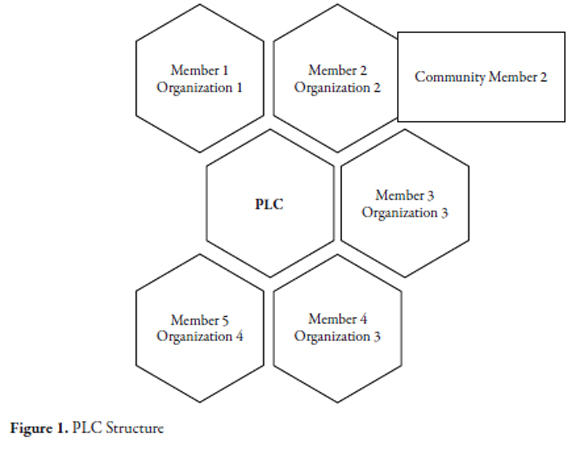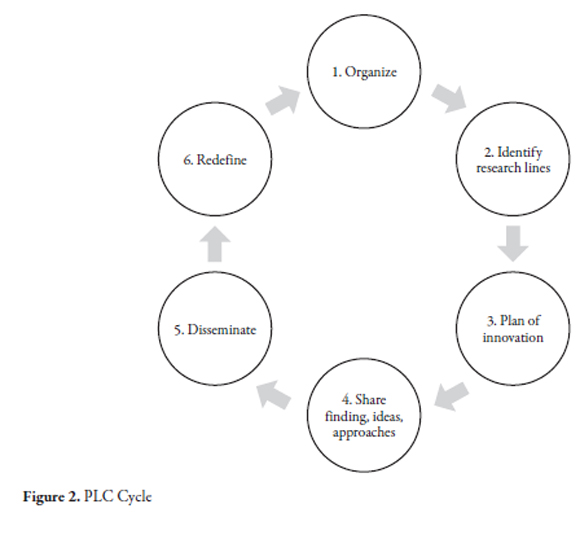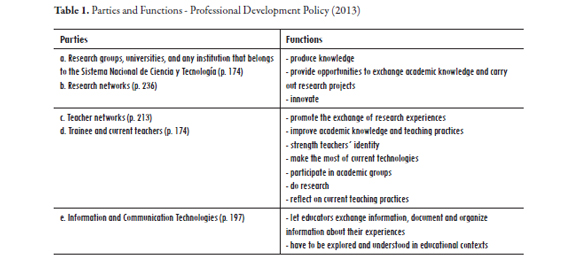
These definitions share a vision of group work, continuous improvement, common interest, collaborative work, and mutual goals. In this article, I conceive a PLC as a group of professionals,
in this specific case in the field of education (professional), who gather together to share experiences and undertake research (learning),
resulting in improved practices in the short term
and in influence on policy makers in the long term
(community).
The literature on PLCs and learning often
mentions the following five core organizational
principles:
1. Supportive and shared leadership
2. Collective creativity/responsibility
3. Shared values and vision
4. Supportive conditions
5. Shared personal practice
Supportive and shared leadership.
Any change in the academic community
demands the involvement of its administrators,
whose leadership engages staff in professional
development activities. Thus, Caine and Caine
(2000) say that PLCs develop teacher-leaders.
While administrators share knowledge, decisionmaking
and provide opportunities for exchanging
ideas, teachers increase their leadership capacities
and use their experience, practices and inquiries to
construct knowledge.
Collective creativity/responsibility.
Louis and Kruse (1995) report that a learning
community is constituted by people from diverse
backgrounds who conduct a reflective dialogue
about students, teaching and learning. They take
part in various tasks that demand proactivity
and the rigor to pursue a goal. In this article the
reflective dialogue is suggested around research
practices. As a way of example, by organizing
online collaborative groups participants may find
a place in the academic world.
Shared values and vision.
According to Reichstetter (2006) and Huffman
(2003), participants in PLCs have in common
the vision of commitment to improvement. In
fact, special attention is devoted to how not just students but also the community participants can
learn. Additionally, as with any organization, the
vision and mission are stated and are followed by
all the members.
Supportive conditions.
Offering space and time for gathering together
and setting clear conditions for operationalizing
the network are two pillars to guarantee the
accomplishment of goals. Support should come
from the inside, meaning the learning community
itself, and from the outside, meaning the current
affiliation of participants.
Shared personal practice.
Teachers work and learn together as they
continually evaluate their practices and the needs,
interests and skills of their students (McREL,
2003). The Colombian educational system would
benefit from a learning community like the one described in this paper since it allows educators
from different educational contexts, backgrounds
and areas of expertise to work together toward a
common goal. Furthermore, knowing what others
are doing in other contexts and understanding
how colleagues address common issues may enrich
individual methods.
Unlike other forms of professional development,
PLCs give each member the chance to be a leader,
which means participants are not mere receivers of
knowledge but also knowledge producers. The five
principles mentioned before provide the path to put
into operation any PLC and lead to research on the
benefits, characteristics and impact on students´
performance as the Center for Comprehensive
School Reform and Improvement (http://www.
centerforcsri.org/plc/) explains.
Stoll, Bolam, McMahon, Wallace, and Thomas
(2006) argue that due to greater job satisfaction,
shared responsibility, and reduction of isolation, the main benefit concerns the impact on students’
performance. Many educators face the same
problems or have the same academic interests, but
take diverse approaches to common situations.
In consequence, a PLC is a space where different
visions of the world may be shared and thus
modified and improved. Although there is
recent evidence on PLCs, Stanley (2011) reports
teachers working together dates back to 1973
with the study on “Federal Programs Supporting
Educational Change” and a 1980 study by Joyce
and Shower. In this report Rand conducted a twophase
study to spread and introduce best practices
in US public schools.
Other evidence of how PLCs work emerges and
benefits both primary and secondary education
is presented by some school districts. South
Elementary in Missouri (2007) and Boones Mill
Elementary in Virginia (2002) reported student
improvement, the former by implementing
common assessment in their literacy instruction
and problem-solving for at-risk learners, the latter
by organizing research teams of teachers who
looked for measurable student achievement goals.
Other examples at the middle school level are the
case of Lewis and Clark Middle School in Missouri
(2003) and of Woodsedge Middle School in Texas
(2003). In the first case participants evaluated data
and later implemented an approach that included
professional development. In the second case,
educators designed curricula to help low achievers.
In both cases results showed student improvement
and collaborative research by teachers. At the
high school level and in 2007, a school in Bogotá,
Colombia did a study on how bilingual education
was implemented in some schools of the same city.
Results showed different understanding as to what
the concept of bilingual education entails.
Other reports refer to the impact of PLC. In
2001 the National Staff Development Council
(NSDC) stated that “the most powerful forms
of staff development occur in ongoing teams
that meet on a regular basis . . . [These] learning
communities or communities of practice operate
with a commitment to the norms of continuous
improvement and experimentation and engage
their members in improving their daily work to
advance the achievement of school district and
school goals for student learning.” (p. 1)
The Department for Education and Skills (DfES),
the General Teaching Council for England
(GTCe) and the National College for School
Leadership (NCSL) from January 2002 to
October 2004 also funded a project entitled
Creating and Sustaining Effective Professional Learning Communities (EPLC). Their main
conclusion was that the creation of PLCs is
worth pursuing for promoting school and systemwide
capacity building. They identified eight
characteristics: shared values and vision, collective
responsibility for pupils’ learning, collaboration
focused on learning, individual and collective
professional learning, reflective professional
inquiry, openness, networks and partnerships,
inclusive membership and mutual trust, respect
and support. PLCs change over time while also
providing a model to follow. The above study
gives more insights for this paper, not only because
it explains the key factors for execution but also
because it gives some general recommendations
for future implementations. These conclusions
resulted from answering five broad questions:
•What are professional learning communities and how has the concept developed?
• What makes professional learning communities
effective?
• What processes do professional learning
communities use, and how do they contribute to the development of an effective professional
learning community?
• What other factors help or hinder the creation and development of effective professional learning communities?
• Are professional learning communities
sustainable?
Other studies have focused on the characteristics
of PLCs. In 2008 the Education Alliance at Brown University in partnership with Hezel Associates
conducted a literature review on PLCs using different databases. Besides the questions posed in the previous study, they also asked, “What is known about technology use to facilitate PLCs? What further studies and research is recommended? How do schools/districts support the development of such communities?”
Also worth mentioning is Kline’s (2007) case study
of three teacher communities of practice. The most
relevant aspect of this study has to do with the
conclusion, in which the researcher affirms that
PLCs have a better chance of success if viewed as
voluntary activities rather than mandatory. This
study also supports the idea of inviting teachers by
asking them “What do you do in case…? How do
you handle…? What if….?” This approach results
in increased motivation and the creation of a real
sense of belonging.
Haneda (2006) explains that communities of
practice may be focused on different areas. In her
case she talks about second language research. One
of the main concerns and proposals in this paper
has to do with Haneda´s assertion that group
work and approaches to practices are better dealt
with when addressed from different perspectives
and that interdisciplinary work lets participants
gain knowledge while providing input.
As it can be seen, there are many reports on how
schools implement PLCs. However, less research
has focused on these communities in university
settings. It can be argued that there is a need to foster
the creation of and evaluate the benefits, impact and
caracteristics of PLCs in the Colombian context.
As Huffman and Hipp (2003) argue, the PLC is
“the most powerful professional development and
change strategy available” (p. 4).
PLCs Operationalization – The PLC
Colombian Model
Professional development through PLCs may only occur if there is a change in the paradigm of how professional knowledge is gained. Educators need
to understand that the basis of any improvement
relies on interaction and the exchange of ideas. Of
course, this demands time and cannot be linked
to a certain number of hours. PD is continuous
and calls for commitment if participants want
to succeed. As stated earlier, a community of
this kind only exists because of the sustained
contribution of each participant. In that sense, it
is plausible that educators belonging to different
affiliations, namely private and public institutions
in rural or urban areas, go into partnership.
This section presents the concept and
operationalization of a PLC, including its outcomes.
The PLC in this article has its origins in the heart
of an academic group integrated by educators of
different backgrounds (schools and universities)
who gathered together to do research. It is expected
that the example shown in this section can serve as a
model in Colombia.
To start with, as in any organization, participants
set clear goals and principles to implement. The
former set the purpose and the latter the norms
that result in a sense of belonging.
PLC goals:
1. Support educators and administrators by
means of a national professional community.
2. Create a learning organization where foreign
language educators and administrators in
Colombia cooperate, learn together, and
show research results.
3. Impact national policies through research.
PLC principles:
a. Open-Mindedness: the ability to accept
feedback and apply learning according to each
member´s educational setting.
b. Mutual respect: value and respect cooperative
work by reflecting on different practices.
c. Trustworthiness: dependent and
interdependent loyalty.
d. Supportive leadership: as representatives
of each institution, each member becomes a
leader for his/her community or educational
system.
e. Understanding: build knowledge together.
f. Commitment: ensure the effectiveness of the
PLC through active participation.
g. Collegiality: all members share power,
authority and decision-making that support
the operation of the network.
PLC action plan:
As with all organizations, PLCs require an action
plan. This plan provides the journey to achieve
the established goals and follow the principles
within the organization. One may say there are
two types of actions. The first set of actions has to
do with the operationalization of the community
itself and provides the foundation. The second set
of actions has to do with how to handle the PD
endeavor and sets the work plan. As it was said
before, the proposed PLC is focused on research
practices.
Some of the actions that should be considered are:
• Set when, where and how participants can come together.
• Evaluate the role of technology. It may be vital as a communication channel.
• State the vision and mission of the PLC.
• Register the PLC (for instance on the Colombia Aprende website)
• Set a work plan.
• Identify research lines.
• Pose research projects.
• Study current educational policies and plan to intervene.
PLC outcomes:
PLCs need to establish clear outcomes. These should be evident and measurable.
Examples of desired outcomes include what
Harris and Jones (2010) sum up in three words, “improved learner outcomes,” in addition to
current methodologies:
• Improve practices
• Do research
• Publish for the educational community
• Impact institutional and national policies
In the Colombian context, like any in the world,
these outcomes have a great impact in the academic
community. Sharing let other practitioners learn
from other practices which is another way to
expand the community.
PLC structure.
Although most of the literature on PLCs
suggests teachers be the members of such
groups, administrators, teachers, and teacherresearchers
may also facilitate the creation of these
organizations. In the Colombian context there
is no restriction as to the kind and number of
members; mainly if one considers participants need
to be replicators in their own communities. Figure
1 shows six members as a way of example; however,
there may be as many members as desired.
Figure 1 displays how the PLC brings together
community personnel from various organizations.
Coming from different groups opens the world
of possibilities for academic work. In any case
participants gain knowledge or complete
assignments that involve their communities. In
this example, member three and four come from
the same organization.

Members´ contributions are relevant for a richer
experience. Eaker and Gonzalez (2006) mention
how collaborative work results in specific
products which depending on the plan set forth
for the PLC.
The figure 2 is proposed in light of previous
information and dynamics in many institutions
of the Colombian educational system. Professors,
for instance, are required to do research and
belong to networks where they can both conduct

research and disseminate it. These professionals
usually belong to research groups. However,
this PLC does not necessarily act as a research
group since participants may belong to different
research groups and use the learning gained in
this community as a strategy to expand their
own. It means the PLC acts as a means to gather
researchers together.
Each stage in the cycle is explained as follows:
• Organize groups: call participants to belong
to the PLC. Explain the PLC structure,
goals, norms, principles and expectations.
Establish the group of participants and
group them according to research interests.
Name the PLC coordinator and distribute
leadership responsibilities. Each member acts
as facilitator for his/her area of expertise.
• Identify research lines or areas of interest:
consider the needs in terms of improvement,
and consider the common problems or issues
for each academic community. If necessary,
organize subgroups within the community.
It is advisable to have leaders for each of the
research lines, although responsibility is
shared.
• Plan for innovation: set a schedule, activities,
and/or sponsorship for events. State tasks and
how to carry out research projects. Schedule
meetings to report progress and a calendar
of activities. Keep in mind participants’
affiliation since institutional policies may bias
work.
• Share findings: share progress and sustained
improvement. Impact is crucial at this stage.
As a consequence, on this stage an assessment
of its impact on its members´ professional
development and on students´ learning may
be reported. In fact research on how the cycle
is influencing participants may be done. Plan
an implementation time line.
• Disseminate: present results, provide
recommendations, act on data collected, and
publish. Find ways to influence policies.
• Redefine: reshape or refine the strategies.
Start a new inquiry based on identified results.
Involve new members in the community.
Following those six steps facilitates a working
plan for community members when planning the
operationalization of the PLC. It is important
for members to guarantee the cycle is followed in
such a way outcomes are achieved.
Conclusion
PLCs offer a magnificent chance for involvement
in professional development activities.
Professional development may be richer if
participants follow the model proposed in this
article which seeks to have an impact on the field
and on national policies. Table 3 summarizes the
operationalization of the PLC model proposed in
this article:

Professional development should be understood
as professional learning. Joint contributions
enrich and improve practices. Although there is
some evidence on how school PLCs operate and
some of their outcomes, there is still much to be
done in order to find out how university PLCs
function and their impact, especially in a country
such as Colombia where even national policies
advocate for their operation.
It is suggested that the model presented in this
article be implemented at many institutions in such a way that the desired impact is achieved and
further research can be done.
Notes
1
author´s translation
2
author´s translation
3
author´s translation
References
Bolam, R., McMahon, A., Stoll, L., Thomas, S., & Wallace,
M. (2005). Creating and sustaining effective
professional learning communities. General Teaching
Council for England. University of Bristol: England.
Caine, G., & Caine, R. N. (2000). The learning community
as a foundation for developing teacher leaders.
NASSP Bulletin, 84(616), 7-14.
DuFour, R. (2003). Building a professional learning
community: For system leaders, it means allowing
autonomy within defined parameters. The School
Administrator. Retrieved March 8, 2008, from http://findarticles.com/p/articles/mi_m0JSD/is_5_60/ai_101173944
DuFour, R. (2004). What is a professional learning
community? Educational Leadership, 61(8),6-11.
DuFour, R., Eaker, R., & Many, T. (2006). Learning by doing:
A handbook for professional learning communities
that work. Bloomington, IN: Solution Tree.
Eaker, R., & Gonzalez, D. (2006). Leading in professional
learning communities. National EakerForum of Educational Administration and Supervision Journal,
24(1), 6-13.
Feger, S., & Arruda, E. (2008). Professional learning communities: Key themes from the literature. Providence, RI: The Education Alliance, Brown University.
Haneda, M. (2006) Classrooms as communities of practice:
A reevaluation. TESOL QUARTERLY, 40 (4),807-817.
Harris, A. and Jones, M. (2010) Professional learning
communities and system Improvement.
Improving Schools, 13(2), 172–181. doi:
10.1177/1365480210376487
Henri R., & Pudelko B. (2003). Understanding and
analyzing activity and learning in Virtual
Communities. Journal of Computer Assisted
Learning, 19(4), 474-487.
Hord, S. (1997). Professional learning communities: What are they and why are they important? Austin, TX: Southwest Educational Development Laboratory (SEDL).
Hord, S., & Rutherford, W. L. (1998). Creating a
professional learning community: Cottonwood
Creek School. Issues about Change, 6(2), 1-8.
Huffman, J. B. (2000). One school’s experience as a
professional learning community. Planning and Changing, 31(1-2), 84-94.
Huffman, J. (2003). The role of shared values and vision in
creating professional learning communities. NASSP
Bulletin, 87, 21-34.
Huffman, J. B., & Hipp, K. K. (2003). Reculturing schools as professional learning communities. Lanham, MD: Rowman & Littlefield.
Kline, M. (2007). Developing Conceptions of Teaching and
Learning Within Communities of Practice. US: University of Pensylvania.
Lave, J., & Wenger, E. (1991). Situated learning: Legitimate
peripheral participation. Cambridge, England:
Cambridge University Press.
Louis, K., & Kruse, D. (1995). Professionalism and
community: Perspectives on reforming urban schools.
Thousand Oaks, CA: Corwin Press.
Martínez, M. C. (2006) La Figura del Maestro Como
Sujeto Político. El Lugar de los Colectivos y Redes
Pedagógicas en su Agenciamiento. Revista Educere,
10(33), 243 – 250.



